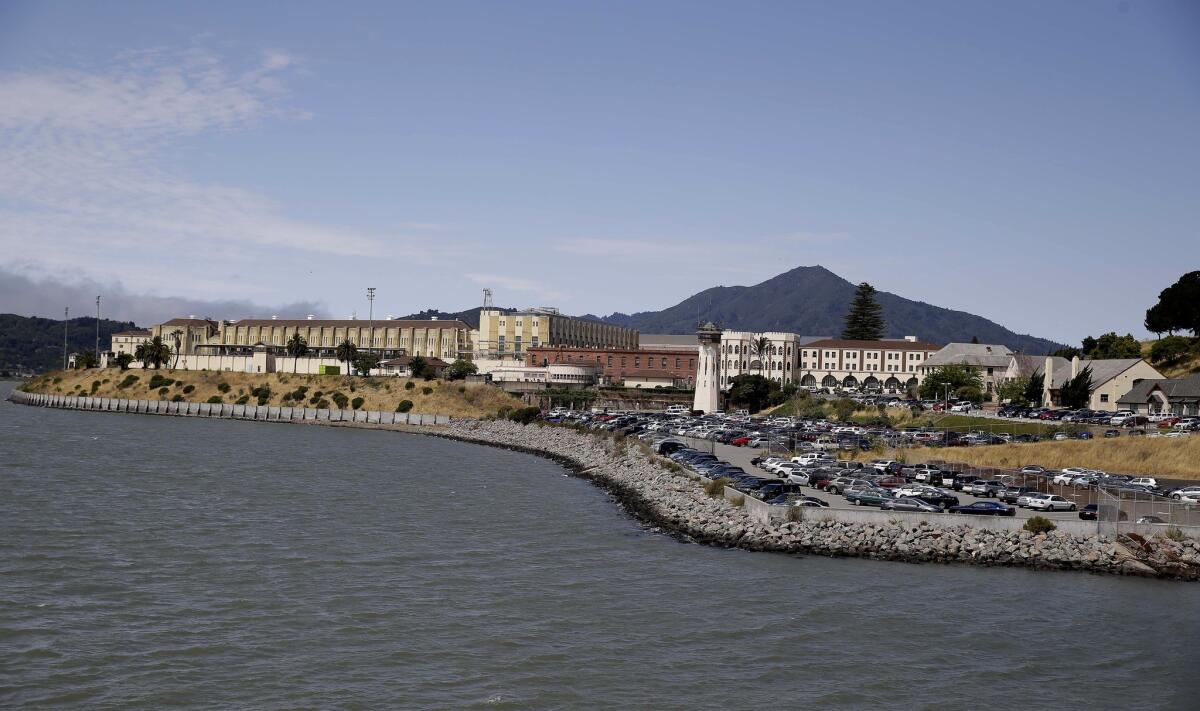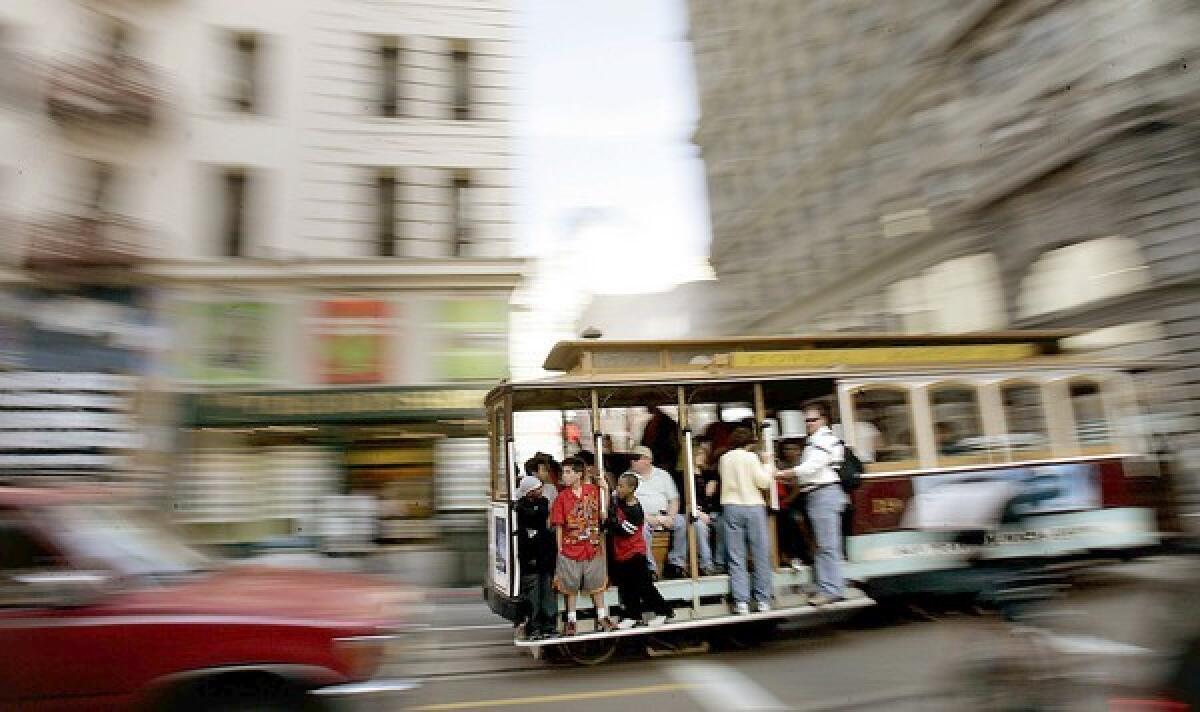Newsletter: How the San Quentin coronavirus outbreak exploded

Good morning, and welcome to the Essential California newsletter. It’s Thursday, July 9, and I’m writing from Los Angeles.
Start your day right
Sign up for Essential California for news, features and recommendations from the L.A. Times and beyond in your inbox six days a week.
You may occasionally receive promotional content from the Los Angeles Times.
Marion Wickerd was on the treadmill in her Palmdale garage when the phone started ringing. It rang once, and then again.
Probably a telemarketer, she thought. There had been a lot of those lately, and she had already spoken to her husband, Tommy Wickerd, who is incarcerated at San Quentin State Prison, that morning.
So she powered on with her workout, speed-walking to a Netflix movie as the sky darkened through the open garage door.
But then it rang a third time. “My gosh, somebody must really want to reach me,” she remembered thinking, as she very nearly took a nasty spill jumping off the still-moving treadmill to reach the phone before it stopped ringing.
It was Tommy, again.
“I just tested positive, I have COVID,” he told her as she struggled to catch her breath. He was, at least at the time, asymptomatic, but said the men around him “were dropping like flies.”
Thirty minutes north of San Francisco on a windswept bluff in Marin County, one of the worst coronavirus outbreaks in the nation continues to intensify inside San Quentin State Prison.
California’s oldest prison has an inmate population of about 3,500, operating well above its designed capacity. About 42% of the population there have been deemed “medically vulnerable,” and health advocates have spoken out about crowding and poor ventilation in the aging facilities.
But even as the pandemic drastically altered the outside world and the virus festered in other correctional facilities around the state, San Quentin had somehow remained unscathed until early June.
Then the transfer buses came. On May 30, 121 men boarded buses headed to San Quentin from the California Institution for Men in Chino, which had been an early hotbed of coronavirus cases in the state’s prison system.
They were part of a transfer of nearly 700 incarcerated individuals, a move that Assemblyman Marc Levine (D-San Rafael) would characterize in retrospect as “the worst prison health screw-up in state history.” Earlier this week, authorities announced the replacement of the state correction system’s top medical officer, which came the same day that Gov. Gavin Newsom described combating the outbreak in the state’s prison system as “a top priority for our administration” and said that the Chino transfer should not have happened.
[Read the story: “Top medical officer for California prisons ousted amid worsening coronavirus outbreak” in the Los Angeles Times]
Theoretically, all the individuals transferred had tested negative for the coronavirus, but the San Francisco Chronicle reports that some hadn’t been tested in weeks, and several of the men were reportedly showing symptoms before they even got off the bus at San Quentin.
By mid-June, 16 incarcerated individuals had tested positive for the virus at San Quentin. From there, it spread like wildfire.
A memo from health experts dated June 15 warned that the prison was experiencing a rapidly evolving COVID-19 outbreak with “profoundly inadequate resources to keep it from developing into a full-blown epidemic,” and cautioned that a failure to meet urgent needs at San Quentin would not only have dire implications for men incarcerated at the prison as well as staff, but would also affect the healthcare capacity of hospitals in the San Francisco Bay Area.
[Read more: “San Quentin prison coronavirus outbreak ‘tragic, predictable and unacceptable’ ” in the Los Angeles Times]
By the end of June, roughly 1 in 3 men incarcerated at San Quentin had tested positive for the coronavirus. According to state statistics, there were 1,309 active infections in the San Quentin prison population as of Wednesday evening, and 184 employees had tested positive for the virus, 14 of whom have since returned to work. There have been at least seven coronavirus-related deaths among the prison population since the outbreak began, according to a state tracker.
“None of those inmates are safe right now, none of them. The CDCR does not have this under control,” the mother of a man incarcerated at San Quentin said over the phone on Tuesday. The woman, who asked not to give her name for fear of retaliation against her son, spoke about her fear that the outbreak would amount to a “potential death sentence” for her son, who is in his early 30s and eligible for release in less than a decade.
As the death toll mounts, Newsom is facing rising pressure to further reduce the prison population, with that pressure coming from legislators, advocates and the federal judge overseeing litigation concerning the treatment of California’s inmates. The governor has said that he hopes to reduce the population at San Quentin to under 3,100 (or about 100% of its designed capacity) within the next several weeks.
[See also: “San Quentin is one of nation’s biggest coronavirus outbreaks. What Newsom does now may affect entire Bay Area” in the San Francisco Chronicle]
“At stake here is the very notion of justice,” the Sacramento Bee Editorial Board declared last week. “Many California inmates are doing time for serious crimes. The question is whether they deserve to die due to an uncontrolled COVID-19 outbreak. Some may still pose a threat, but many elderly and medically vulnerable prisoners are being kept behind bars for the sake of punishment rather than justice.”
Also at stake is the operational capacity of the broader hospital system in the area, as California coronavirus cases continue to surge well outside prison walls. Marin County officials said last week that local hospitals have been inundated with intensive care patients from the prison, and Peter Chin-Hong, an infectious disease specialist at UC San Francisco, told my colleagues that prisons, especially San Quentin, will probably have an impact on hospitals in the coming weeks as inmates and staff need greater levels of care.
“As the inmates start to get sicker and require hospitalization, not only are Bay Area hospitals going to feel it, hospitals across the state are going to feel it,” Chin-Hong said. Chin-Hong said he also worries that stocks of drugs such as Remdesivir will run out.
Marion Wickerd said she had barely slept more than two or three hours a night since her incarcerated husband received his positive coronavirus test two weeks ago. As soon as she wakes up, the same thoughts immediately begin to rapid-cycle through her head: How can I help, what can I do, who’s going to help?
And now, here’s what’s happening across California:
For weeks, COVID-19 deaths remained relatively flat in California, even as case and hospitalization numbers soared. But the tragic spike in deaths that experts had been predicting finally came to pass on Wednesday, as the state recorded its highest single-day COVID-19 death toll since the pandemic. There were 149 fatalities reported, according to a Los Angeles Times county-by-county tally. Statewide, the number of coronavirus-related hospitalizations has also continued to march upward, while the number of people in California’s intensive care units has soared.
On Wednesday, Newsom added Napa, Yolo and San Benito counties to the state’s watch list of counties being monitored for their rising case counts and increased hospitalizations. The list now includes 26 of California’s 58 counties. Los Angeles Times
L.A. STORIES
Los Angeles County recorded its worst daily coronavirus death toll in at least a month on Wednesday, which may be the result of increased disease transmission that probably began around Memorial Day. Los Angeles Times
With demand soaring, L.A. County narrows priority for who should get coronavirus tests. Priority will now be given to those showing symptoms, who work in a high-risk environment or who have come in contact with a person known to have been exposed to the virus. Los Angeles Times
L.A. County’s top health official warned that the coronavirus surge jeopardizes the reopening of K-12 schools in the county. She told education leaders that the pending reopening of K-12 campuses is suddenly at risk because of the ongoing surge, and all public and private schools must prepare for students to continue learning entirely from home. Los Angeles Times
An independent autopsy found that Andres Guardado was shot five times in the back. The 18-year-old was killed by a Los Angeles County sheriff’s deputy in Gardena last month. Los Angeles Times
Support our journalism
POLITICS AND GOVERNMENT
A group of Democratic challengers to incumbent Republican U.S. senators has once again posted massive fundraising numbers, raising the party’s hopes of reclaiming the Senate from the GOP in the November election. Los Angeles Times
Newsom says the reopening of California schools will be based on safety, not pressure from President Trump. The governor said Wednesday that a decision on reopening California schools this fall will be made by local education and health officials weighing the state of the COVID-19 pandemic, and emphasized that he won’t be swayed by statements from Trump urging campuses to bring back students quickly. Los Angeles Times
The Supreme Court cleared the way for a Trump administration regulation that would free employers from providing contraceptives to their employees if the company’s owners have a religious or moral objection, potentially leaving more than 120,000 women with no coverage. Los Angeles Times
San Francisco Mayor London Breed is awaiting the results of a coronavirus test after public health officials informed her she had been exposed to the coronavirus and there was a moderate risk that she had been infected. San Francisco Chronicle
CRIME AND COURTS
A Danville father was fatally shot while on an off-roading trip with his teenage son. The 45-year-old doctor died at the scene, while his son spent 30 hours alone and lost in the dense woods of Sierra County before being rescued. San Francisco Chronicle
Ventura County officials are searching for “Glee” actress Naya Rivera after she went missing Wednesday while boating at Lake Piru with her son. Authorities said Rivera rented a boat and may have drowned while swimming. Her 4-year-old son was found sleeping on the boat by himself by other boaters in the lake. Los Angeles Times
HEALTH AND THE ENVIRONMENT
Endangered California condors are back in Sequoia National Park for the first time in 50 years. At least six of the giant birds were spotted in the park in late May, biologists said, a testament to the continued recovery of the species. Los Angeles Times
[Previously: “How the California condor returned from the brink of extinction” in the Los Angeles Times]
CALIFORNIA CULTURE
San Francisco’s beloved cable cars probably won’t run again until a coronavirus vaccine is ready. For now, the orange and burgundy beasts are gathering dust in a brick barn on Mason Street, where they’ve been hibernating since March. San Francisco Chronicle

Summer rental rates for Malibu houses on coveted beachfront property have soared. One owner recently put their home up for rent to cash in, listing it for $40,000 more a month than its “usual” [read: already exorbitant] summer price. The Hollywood Reporter
This year’s midsummer bloom of sunflower fields in Yolo and Solano counties has attracted staggering numbers of picture-seeking tourists, leaving area growers frustrated by broken stems and parked cars blocking the entrances to roads used to move machinery around or access irrigation pipes. Sacramento Bee
A Lake Elsinore man killed by the coronavirus warned others in his final Facebook post. Tommy Macias, 51, wrote about how he had been an “idiot” and attended a barbecue where guests didn’t wear masks. “This is no joke,” he wrote, exhorting others to take precautions. He started having trouble breathing the next morning, and died later that day. Riverside Press-Enterprise
A poem to start your Thursday: “Poet’s Work” by Lorine Niedecker. Poets.org
Free online games
Get our free daily crossword puzzle, sudoku, word search and arcade games in our new game center at latimes.com/games.
CALIFORNIA ALMANAC
Los Angeles: partly sunny, 80. San Diego: sunny, 75. San Francisco: sunny, 75. San Jose: sunny, 87. Fresno: sunny, 102. Sacramento: sunny, 100. More weather is here.
AND FINALLY
Today’s California memory comes from Marge Solari:
In the 1960s, my brother and sister often sent for tickets to shows. Then they would jump into his Volkswagen bus, get on the freeway and go to Hollywood. One time we all went to “Let’s Make a Deal.” I wore a wedding dress and granny boots. My sister wore a colander decorated with kitchen utensils on her head. My brother wore a mumu, a wig, and flip flops. We got to sit on the trading floor but were not picked to deal. Still, it was a pretty exciting day.
If you have a memory or story about the Golden State, share it with us. (Please keep your story to 100 words.)
Please let us know what we can do to make this newsletter more useful to you. Send comments, complaints, ideas and unrelated book recommendations to Julia Wick. Follow her on Twitter @Sherlyholmes.
Start your day right
Sign up for Essential California for news, features and recommendations from the L.A. Times and beyond in your inbox six days a week.
You may occasionally receive promotional content from the Los Angeles Times.




